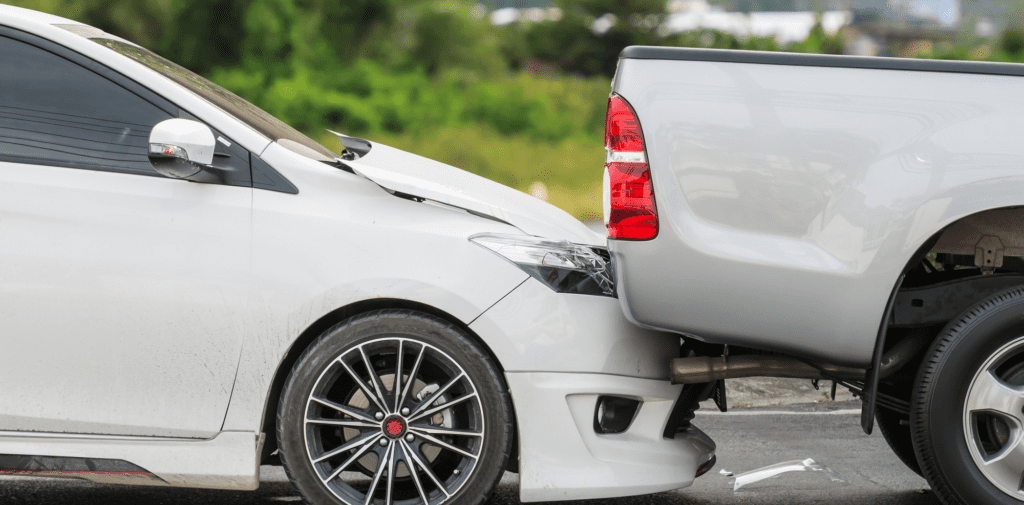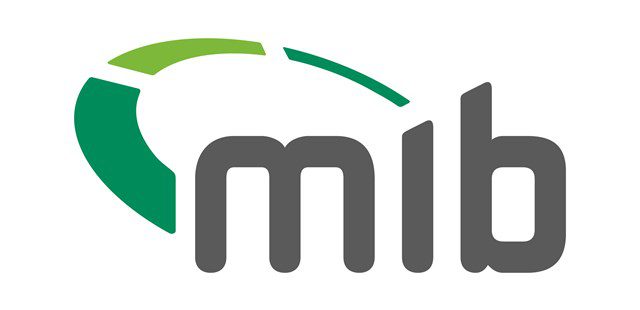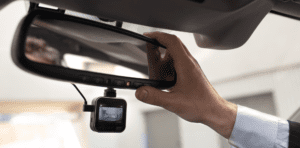Compare cheap car insurance
✔ Compare cheap car insurance quotes
✔ Over 110 insurance providers
✔ Get a quote in minutes
✔ Save up to £504*


Experiencing a car accident is invariably jarring, and it feels even more unjust when you’re not the one at fault.
- What is a non-fault claim?
- How do I know who is at fault for a car accident?
- Does the level of my car insurance affect my claim?
- Is claiming on my car insurance worth it, if it wasn’t my fault?
- Do I need to declare a non-fault accident?
- Does declaring a non-fault claim affect my car insurance?
- Does a non-fault accident affect a no-claims discount?
- How can I lower the cost of my car insurance after an accident?
If you find yourself in such a situation, you might wonder: Should you claim on your car insurance or does the responsibility lie with the other driver? Here’s the lowdown on no-fault accidents.
What is a non-fault claim?
A non-fault car insurance claim refers to the process you initiate when you’ve been involved in a car accident that wasn’t due to your negligence or mistake.
In such situations, your insurance provider typically seeks to reclaim the total expenses of the claim from the responsible party, often termed the ‘liable party’.


Contrastingly, an ‘at-fault’ claim is initiated when you are the party responsible for the damages. This means you bear the liability.
However, scenarios exist where you may not be the cause of the accident, yet the claim might still be classified as an ‘at-fault’ insurance claim.
One such scenario arises when an accident is caused by an unknown or unidentified at-fault party. For instance, if an animal unexpectedly darts onto the road causing you to swerve and crash, or if another driver is the instigator of the accident but flees the scene without being identified, there may not be a specific entity or individual to pursue damages.
In such cases, even though you were not the direct cause of the accident, the lack of another party to hold you accountable means the responsibility falls on you, making it an ‘at-fault’ claim. This can potentially impact your car insurance premiums and your claim history.
How much can you save on your car insurance?
How do I know who is at fault for a car accident?
When an accident occurs, one of the foremost concerns is identifying who is liable for the damages and potential injuries.
Such identification helps in the classification of the claim as either non-fault or at-fault during the insurance claims process.


To establish fault accurately, insurance companies employ a comprehensive evaluation of all available evidence. The evidence they consider includes:
- Video recordings: These could be sourced from speed cameras, local CCTV systems, and dashboard-mounted cameras in vehicles.
- Photographic proof: Immediately after the accident, if circumstances allow, it’s advisable to capture clear photographs of the damage, the surrounding environment, and any relevant road markers or signals. This provides a visual record of the aftermath.
- Eyewitness accounts: These are statements from individuals who observed the incident as it unfolded. Their testimonies can provide varying perspectives and crucial details about the accident.
- Official documentation: Reports prepared by police attending the scene or medical professionals treating injuries play a crucial role. These reports present an objective, third-party view of the incident and its ramifications.
An important note to remember is to refrain from making immediate apologies after an accident. While it may feel instinctual and polite, such actions could inadvertently be interpreted as admissions of fault or responsibility, potentially impacting the outcome of the claim.
After a thorough examination of the accumulated evidence, the insurance company will conclude who bears the responsibility for the accident. If you find yourself in disagreement with their decision, you have the right to challenge it.
Start by drafting a letter to your insurance provider, explaining your stance and presenting any supporting evidence. If the ensuing resolution remains unsatisfactory, you can escalate your grievance to an external body like the Financial Ombudsman Service (FOS) for an impartial review.
How much can you save on your car insurance?
Does the level of my car insurance affect my claim?
When it comes to car insurance claims, the level of your insurance cover can play a significant role in determining your entitlements.


Here’s a deeper look into how it can impact your claim:
Not at Fault for the Accident
If investigations determine that you were not at fault for the accident, then the level of your insurance typically doesn’t influence the amount you receive as a payout.
Instead, the claim is directed towards the other driver’s insurance policy. The essential thing is that the other driver must have, at the very least, third-party car insurance.
This is the baseline cover mandated by law. Once this is in place, their insurance should ideally cover the expenses associated with the accident. This includes but is not limited to:
- The cost of repairs for damages incurred.
- Provision of a courtesy car, if applicable.
- Any other relevant compensation costs.
However, even if you’re not at fault, remember that you might still need to settle any excess specified in your policy terms.
At Fault for the Accident
On the flip side, if the outcome of the investigation reveals that you were indeed responsible for the accident, then the nature of your cover becomes crucial.
In this situation, to claim compensation—whether it’s for repairs to your car, medical expenses, or other related costs—you’d require a fully comprehensive car insurance policy.
This type of policy offers a broader range of protection, covering damages to your car even if the accident was your fault, among other benefits.
Without such cover, you may find yourself shouldering significant out-of-pocket expenses.
How much can you save on your car insurance?
Is claiming on my car insurance worth it, if it wasn’t my fault?
Determining whether or not to claim on your car insurance when the accident wasn’t your fault necessitates consideration of various factors. Here are expanded insights to guide your decision:
Claiming From the Other Driver’s Policy
If another driver is found to be at fault for the accident, you usually have the option to claim compensation directly from their insurance provider, assuming they have valid insurance.
Under such circumstances, there’s generally no need to tap into your own insurance policy. This approach means that your no-claims bonus and subsequent premium rates should remain unaffected.
Essentially, the financial responsibility for the accident-related expenses, including repairs and any medical bills, would fall on the at-fault driver’s insurance.
Dealing With Uninsured Drivers
In unfortunate instances where the at-fault driver is uninsured, you still have alternatives. One option is to make a claim with the Motor Insurers’ Bureau (MIB).
The MIB is designed to act as a safety net, providing compensation to individuals who have been involved in accidents with uninsured or untraceable drivers.
This process may be lengthy but is a valuable recourse in the absence of other insurance cover.
Alternatively, if you possess comprehensive insurance cover, you can decide to claim on your own policy.
However, be aware that this might affect your no-claims discount, even though the accident wasn’t your fault.
Weighing the Severity of Damage
For minor or purely cosmetic damages, the practical route might be to forego insurance claims entirely and cover the repair costs out-of-pocket.
The rationale behind this is that the act of making a claim on your insurance — regardless of fault — can potentially jeopardise your no-claims bonus, leading to increased premiums in the future.
If the repair costs are relatively low, it might be economically sensible to handle them yourself to preserve your discount and keep future premiums in check.
Mandatory Notification
Regardless of the path you choose, one constant remains: you must inform your insurance provider about the accident.


This notification is a standard requirement, even if you opt not to proceed with a claim. Failing to report an accident to your insurer can lead to complications and potential policy violations, which could be detrimental should you need to file a claim later on.
Always consult your policy’s terms and conditions to understand your responsibilities and the implications of any action you decide to take following an accident.
How much can you save on your car insurance?
Do I need to declare a non-fault accident?
Yes. You must declare all accidents, irrespective of who is at fault.
Each insurance company typically incorporates a clause within their policies mandating the declaration of any incidents occurring while driving, extending back to a general period of five years.


Such clauses necessitate that you report all accidents, not just those where you were deemed at fault.
Failure to comply with these declaration requirements can lead your provider to label your omission as ‘non-disclosure‘.
This classification is serious, carrying with it the potential to render your insurance policy invalid. An invalidated policy not only jeopardises any ongoing claims but may also complicate your efforts to secure insurance cover in the future, given that providers often inquire about past insurance violations during the application process.
Thus, to maintain the integrity of your current policy and safeguard your insurability, adhering to declaration mandates is essential.
How much can you save on your car insurance?
Does declaring a non-fault claim affect my car insurance?
Yes, the declaration of a non-fault claim does bear implications for your car insurance.
Such claims are documented on your claims history, a record that insurance providers scrutinise closely. A non-fault claim, despite not stemming from your actions, often results in increased premiums.


This uptick in premiums is attributed to the perception of risk held by insurance companies. Even if you weren’t at fault, the mere involvement in an accident can lead your provider to categorise you as a higher-risk client moving forward.
In the eyes of insurance companies, individuals with a history of claims, regardless of fault, statistically present a heightened risk of filing future claims, thereby warranting higher premiums to offset this risk.
How much can you save on your car insurance?
Does a non-fault accident affect a no-claims discount?
Typically, a non-fault accident should not influence your no-claims discount negatively.


A no-claims discount (NCD), or no-claims bonus, is a significant reduction in your car insurance premium that you accrue over time by not making claims on your policy. It’s designed to reward safe, cautious drivers who avoid accidents.
Understanding the Guidelines
Non-fault claims are those where the policyholder is not deemed responsible for the accident. In such instances, the insurance companies usually recover costs from the at-fault party’s insurer.
Because you, as the policyholder, aren’t accountable for the accident, your NCD generally remains intact.
This principle reflects the fundamental premise of the NCD, which is to reward your driving behaviour, not necessarily the absence of claims.
Check Your Policy Wording
However, it’s crucial to examine the specific terms and conditions outlined in your individual insurance policy since practices can vary between different insurance providers.
While many insurers adhere to the convention of preserving NCDs after non-fault accidents, others might have unique stipulations or approaches to handling such situations.
Some policies might have clauses that affect your NCD or premium rates after any claim, regardless of fault.
It’s also worth noting that while your no-claims discount might remain unaffected, the underlying premium cost might still increase after a non-fault claim.
Insurance companies calculate premiums based on a complex matrix of risk assessments. Being involved in an accident, even if not at fault, might place you in a higher risk category in the eyes of insurers, potentially leading to an increase in the base premium.
Consider Professional Advice
Given the nuances and variations in policy terms, it’s advisable to consult with your insurance provider or a knowledgeable insurance advisor to understand fully how non-fault claims might impact your NCD and overall premium rates.
They can provide clarification and guidance tailored to your specific policy and circumstances, ensuring you’re informed and prepared for any eventualities related to non-fault claims and your no-claims discount.
How much can you save on your car insurance?
How can I lower the cost of my car insurance after an accident?
Reducing your car insurance costs post-accident can indeed be challenging but is feasible with the right strategies in place. Below are various approaches to consider:
Add a Named Driver to Your Policy
Adding an experienced named driver into your policy can be a good move. This strategy distributes the perceived risk from the insurer’s viewpoint.
If the added driver has a robust driving record and substantial experience, it could lead to a reduction in your premium.
However, it’s crucial to accurately represent who primarily operates the car. Misrepresenting this information—by listing a safer driver as the main driver when they are not—can be classified as “fronting,” a form of insurance fraud that is illegal and can lead to severe penalties, including policy cancellation and legal action.
Increase Your Voluntary Excess
Voluntarily opting for a higher excess—the amount you pay out of pocket in the event of a claim—can lead to lower premium costs.
By choosing to shoulder a more significant portion of the risk, you effectively reduce the financial liability for the insurance company, which may result in lower premiums.
However, it’s imperative to ensure that you can comfortably afford the combined compulsory and voluntary excess if you need to make a claim.
Invest in Additional Driving Qualifications
For newer drivers or those who’ve recently passed their driving test, investing in additional driving courses like Pass Plus can be advantageous.
Courses like these expand your driving skills and knowledge, making you a safer driver in the eyes of insurance companies, which may translate to lower premiums.
It’s advisable to check with your insurance provider to understand which courses they recognise and the potential impact on your premiums.
Consider Telematics or Black Box Insurance
Telematics, or black box car insurance, involves installing a device in your vehicle that meticulously tracks your driving habits and behaviours.
The data collected by this device is used to assess your risk level as a driver. Demonstrating consistently safe driving habits through this technology can positively influence your premiums, leading to potential savings.
Shop Around and Compare Quotes
It’s always a wise decision to actively compare car insurance quotes from various providers. Each company uses different criteria and risk assessments when calculating premiums, leading to variability in pricing.
Comparing quotes from a diverse range of providers ensures that you secure the most cost-effective deal aligned with your needs and circumstances.
Utilise online comparison tools like Comparoo and consult with insurance advisors to navigate the myriad of available options efficiently.
Taking the time to review and compare can lead to significant savings on your car insurance premiums post-accident.
How much can you save on your car insurance?












